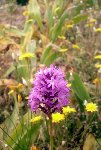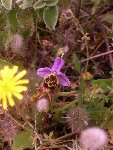|
|
||||||||
|
|
||||||||
 |
|
Crete, May 2011 A trip to a Minoan town at Gouvres is a wasted journey - nearly. Possible because of austerity measures by the Greek government it is closed; there were no notices about this or reduced openings. Anyway, at the layby outside the site were some A. pyramidalis and one of the Tongue Orchids, later identified as Serapias bergonii. This is a species I have not seen before, so for me that made better. Another day another ancient ruin, this time its of the Dorian period. Lato is up in the hills perched on hillside looking like Machu Pichu in miniature (but only in parts and if you squint and hold your breath). Again there are Pyrimidals in the short grass, and a very nice Ophrys minoa (Minoan Bee Orchid), endemic to Crete, so that is a bonus. It is quite Bee Orchid like, but significantly and recognizably different. There is an obligatory boat trip to Spinalonga, the old Venetian fortress and leper colony, where we are abandoned on the island of Kolothika for half an hour for lunch. Here we find some examples of both Anacamptis pyrimidalis and a Gymnodemia species. While the flower looks more like the former, on some the actual plant is tall and slender and flower spike quite unlike pyramidalis. Unfortunately my camera is playing up and not coping with the bright light well at all. On reviewing the pictures most have to be rejected. |
|
|
||||||||||||||||||||



